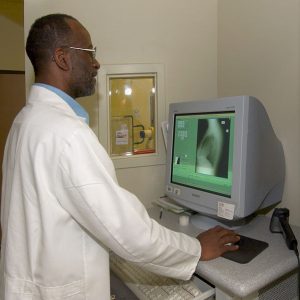Reject Analysis in Radiography and Its Importance for X-ray Techs


Repeat imaging is associated with unnecessary radiation exposure of both patients and staff as well as an increase in operational costs. A basic component of the quality assurance program at medical facilities is reject analysis in radiography. This periodic evaluation helps determine the cause for repeat exposures.
All images that are rejected due to inadequate quality are categorized by cause, for example, equipment problem, operator error, or patient-related factors. The main reasons for retakes in medical imaging include poor positioning, exposure errors, and equipment malfunction. The objective of reject analysis is to use the information to reduce the number of retakes. Depending on the results of the reject analysis, equipment errors are corrected and technical skills improved through training.
What is the objective of reject film analysis?
The primary objective of reject analysis in radiography is to examine the reasons why films are discarded, in an effort to minimize patient exposure to radiation from repeated studies, reduce cost, improve efficiency and throughput, and enhance image quality. Repeat images are a leading contributor of unnecessary exposure and they unduly contribute to patient exposure in radiography. In diagnostic radiology, delivering diagnostic quality images with minimum exposure to staff and patients is of primary importance. If you want to learn more about radiation safety and patient exposure, purchase our course on PACS and Digital Radiography which will earn you 18 CE credits towards ARRT® registration.
How to ensure that the reject analysis program works?
For the reject analysis program (RAP) to work efficiently, it is essential that everyone in the department participate in the program, especially radiologists. All non-diagnostic quality images should be flagged by the radiologist and both negative and positive feedback should be provided as part of the reject analysis in radiography. It’s helpful to have a message system integrated with the PACS viewing system that can be used to send e-mail alerts to the technologists and physicists for image review. Any negative feedback should result in an investigation and resolution. For the RAP to be successful, it is necessary for radiologist feedback to be incorporated in the reject data analysis. This is a value-driven strategy for quality patient care.
Why is standardization important for reject analysis?
It is essential that the reasons for rejection are standardized and explained, with some customization possible depending on the type of practice setting. The reject analysis in radiography program should provide a choice between standardized reasons for rejection such as positioning, exposure error, grid error, system error, artifact, patient motion, test images, or other reason. The acquisition station or digitizer should be identified to specify the origin of the image where the problem occurred. The accession number should link the study through the RIS, and the exam date and time should be included to allow sorting of data on a temporal basis.
The body part and view of the radiologic image should also be included for sorting. The exposure indicators are required for analysis and troubleshooting. The standardized reject category allows efficient analysis. The technologist ID should be included in the rejection analysis in radiography program to identify trends and provide feedback to the appropriate person. Optional inclusions in the RAP can be reject comments to provide further clarification on the reason for the rejection, technical factors for troubleshooting, and a thumbnail image informing the QC of the reason for the rejection.
What is the role of the quality assurance program?
A good quality assurance program for DR and CR systems includes analysis of repeats and rejects and image review based on American Association of Physicists in Medicine (AAPM) guidelines as well as the recommendations from the vendor. In 2007, the AAPM created a task group to outline procedures and make recommendations for QC in digital radiography. The result is a report called the TG-151 Draft Report. This report is continuously updated and a current copy can be found on the AAPM website.
One or more technologists on staff should be assigned QC duties. This QC technologist should work in conjunction with a physicist to measure the exposure index and reject analysis in radiography as well as evaluate feedback from radiologists on image quality. A qualified medical physicist should design and oversee an annual review and provide consultation. The QC technologist should review rejected images, collect and analyze data, keep records, identify and implement corrective actions, and notify the physicist and radiologists of any problems. The radiologists should be involved in the overall design and overseeing of the reject analysis program and help to identify non-diagnostic quality images. Rejected images should be sorted by rejection reason. Reject analysis in radiography should include information which can help identify areas which need improvement.
Some of the same issues which led to repeat exposures using film are still haunting us today and have not changed with the digital environment. These issues include patient positioning errors, and incorrect or improperly exposed images.
Is reject analysis needed in digital imaging?

Back in the days of film radiography, rejects included all rejected films including repeats or retakes. Repeat films resulted in additional exposure to patients. With film, there was a physical inventory to monitor. This made reject analysis in radiography relatively easy. If an excessive number of films were thrown into the recycling bin, it was an indication that there was a problem.
Modern digital radiology systems contain a database of all the information that is needed for a functional and effective RAP. This data can often be remotely accessed through a web browser, or it can be downloaded on-site via USB. This data should be backed up frequently. The recommendation is for vendors to provide remote access to digital radiology system databases because local databases are unreliable and regular downloads are necessary to avoid loss of data, especially following servicing.
With no physical evidence, how do we track rejects in digital radiography?
In digital radiography, rejects include all rejected images. Again, repeat images result in additional patient exposure, but there is no physical evidence (in the form of film) that the extra exposure occurred. This makes reject analysis in radiography with digital systems a little more challenging. This record is digital and on the modality. Some systems employ a digital audit trail to see who did what, but digital images can in some cases be deleted, or forgotten about, without knowing who did it. If there is no digital audit trail, or if the systems are not used to accommodating it, then it is very difficult to find out, for example, if a patient is exposed three times for a two-view ankle exam, with one view thrown out. Therefore, honesty and accurate reporting should be highly encouraged and rewarded along with encouraging and rewarding those who avoid making mistakes in the first place.
What are some of the common reasons for reject images in digital radiography?
Digital radiography eliminates processing problems since X-Rays do not need to undergo the development process. Although the wider exposure latitude of DR in digital image processing makes rejection less likely due to exposure levels, there are new errors encountered in digital radiography which can lead to rejection of images. This the reason reject analysis in radiography with digital systems is extremely important. These include image plate artifacts, double exposure, and backscatter. Artifacts due to talcum powder, deodorant, earrings, and hair buns have also been noted, as have errors due to ribbing on clothes, jewelry, hearing aids, and lighters in pockets. Grid cutoff and scattered fog are also reasons for rejection, as are scratches, dirt on screens, and sand bags. Intrauterine devices can also cause artifacts, and motion artifact is another reason for rejections.
How are X-ray techs affected by reject analysis?
Staff members of a radiology department must work in close cooperation with each other and rely upon their education, training, and experience to fulfill their responsibilities since patient care quality is at stake. Reject analysis in radiography is a necessary procedure to ensure confidence that the quality of the radiographs is meeting industry standards and requirements.
Medical X-Rays are the manmade source of ionizing radiation that is responsible for the most significant amount of radiation exposure to the public, and reject analysis can help minimize this. With the increasing dependence of clinicians on diagnostic radiology as a clinical tool, there has been an exponential increase in the number of high-dose x-ray examinations that are performed, the result of this is a significant increase in exposure of not only individual patients but the staff and collective population as a whole. Reject analysis in radiography is one of the ways in which unnecessary exposure can be controlled.
What should the X-ray tech do to avoid rejects?
The radiographer is responsible for verifying the patient identification and study or examination type, correctly positioning the patient, verifying each view, and ensuring adequate image quality. In digital radiography, the radiographer, or lead, should verify the exam in PACS and reconcile the available image with the correct patient medical record in PACS if needed. All substandard images should be reported, as should any incidental erasure of digital images on the modality or in PACS. This is an integral part of reject analysis in radiography.
Cassette-based image receptors should be cleaned weekly and a log kept of the cleaning. Reject analysis data should be compiled and analyzed regularly. The lead radiographer should verify routine calibration checks, and the medical physicist should conduct a review with the technologists regularly also. Receptor calibrations should be verified every quarter by the quality assurance committee, and a medical physicist should test x-ray generator functions semi-annually.
How can a reject analysis in radiography program be successful?
For any reject analysis in radiography program to be successful, the management of the healthcare organization must also commit to the QA/QC program by allotting sufficient technologists and time to the program and ensuring program continuity. Additionally, policies need to be designed with the understanding that mistakes can happen. Policies that are harsh on technologists for repeating exams may only lead to mistakes being covered up instead of being reported. The rejection rate is defined as the number of rejected images divided by the total number of images acquired at a facility. While this provides an overall figure for reject analysis, it is a simple calculation that does not identify underlying causes and practice problems, for which data analysis is required.
Get more information about xray continuing education courses here.
